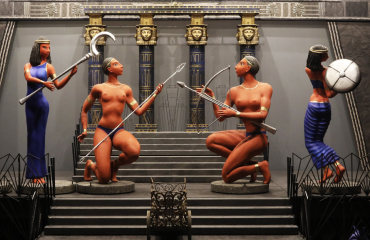Vladimir Gorbunov & Ksenia Goncharova. The Industrial and the Human
Erarta Museum presented an exhibition by Vladimir Gorbunov and Ksenia Goncharova inspired by living in the Southern Urals region
-
The pre-Internet world tragically lagging behind modern times
-
Handmade panels posing as digital art and objects conceived as traces of a vanished civilisation
-
The ditching of techno-optimism in favour of pristine human beauty
The exhibition featuring works by the artist couple Vladimir Gorbunov and Ksenia Goncharova was inspired by living in the South Urals region – the artists’ homeland imbued with the magic of Pavel Bazhov’s fairy tales heard during childhood years. It is here, to these vast expanses, mountains, and clear blue lakes, that the couple returned from St. Petersburg upon completing their studies at the Academy of Arts. Some 30 miles away from the village where the artists currently reside is Karabash, an environmental disaster of a town in which a gigantic pile of copper plant waste keeps growing to no end. Pictures taken in the vicinity of Ksenia’s home town truly boggle the mind, while any accounts of life in the area sound like chthonic mythology. However, the pixelised flower images created by Ksenia and the quirky remains of electric goats conjured up by Vladimir apparently shun the environmental agenda.
Both Ksenia and Vladimir are concerned with the currently relevant issues of technological breakthroughs and irreversible digital progress. The universe in which the artists find themselves immersed bestows upon them by far more impressions than any TV series or comic book ever could. It was rather by instinct than design that Vladimir Gorbunov discovered the sci-fi aesthetics: his characters and the world around them tragically lag behind cutting-edge technology. They are out of touch with the modern trends, but already aware of the feelings of future humans, like love for the family car or respect for the sheer force of the excavator.
In an attempt to better understand his contemporaries, Vladimir, who had spent some time practising photography and video art, ultimately returned to painting. The focus of his interest in familiar things shifted towards the gaps allowing otherness shine through, be it in the form of radiant magical light or an absurd gaudy T-shirt print discordant with the otherwise solid image of the artist’s close family member.
Both artists more or less look to the past, to the world before the Internet. This is evidenced both by the handcrafted panels trying to pass for digital art and by Vladimir Gorbunov’s found objects. Their creative world is being mercilessly advanced upon by the progress, but the skins of electric goats and cyberfish miraculously surviving in bottomless lakes suggest that new technologies fell short of our expectations. Vladimir Gorbunov and Ksenia Goncharova seem to discover and reveal to mankind the relics of an apparently advanced civilisation that once thrived in the Urals but vanished almost without a trace. This artistic gesture renounces techno-optimism in favour of something more important, such as pristine human beauty – even if the human body is ridden with traces of the high culture.








